How to wash a wedding dress at home in a washing machine
 A wedding is a significant event, the memory of which the newlyweds want to preserve for the rest of their lives. And if impressions and emotions remain only in the memory of the spouses, then some traditional attributes, for example, the bride’s outfit, can be saved in reality. Very rarely does a girl manage to protect her formal dress from contamination; mainly, after the wedding ceremony and subsequent banquet, various kinds of stains remain on the snow-white fabric. Is it possible to wash a wedding dress in a machine, and how to restore the original appearance of the dress, we will talk in this article.
A wedding is a significant event, the memory of which the newlyweds want to preserve for the rest of their lives. And if impressions and emotions remain only in the memory of the spouses, then some traditional attributes, for example, the bride’s outfit, can be saved in reality. Very rarely does a girl manage to protect her formal dress from contamination; mainly, after the wedding ceremony and subsequent banquet, various kinds of stains remain on the snow-white fabric. Is it possible to wash a wedding dress in a machine, and how to restore the original appearance of the dress, we will talk in this article.
Basic recommendations
A soiled bride’s dress can darken the impressions of the last wedding celebration, but you still shouldn’t get depressed about the “damaged” thing. A young wife can revive the outfit, returning it to its former whiteness.
You can use the services of express cleaning points, but, unfortunately, the results of the work do not always meet the expectations of customers. Aggressive compounds used in modern dry cleaners can cause irreparable damage to the product, especially if the dress is made of non-standard, delicate fabrics. After such processing, a luxurious formal outfit can easily turn into a “Cinderella dress.”
Therefore, you need to contact either a trusted dry cleaner, where each client receives an individual approach, and all wishes are taken into account by specialists, or you need to clean the dress at home. By doing the washing yourself, you can analyze the type of stains on the fabric and choose the appropriate methods for removing stains.This way the effect will be best and the process will be as safe as possible for the item.
Before cleaning your wedding dress, you should carefully study the product label to understand which methods of exposure to the fabric are acceptable and which are not.
 The hostess should inspect the outfit for stains. In almost one hundred percent of cases, road dust and dirt remain on the hem. In places, under the armpits there are yellow circles from sweat. Also, the staleness of the fabric can be noted on the inside of the bodice. When preparing a dress for washing, study what materials it is made from. Often products of this kind are made from synthetic fabrics that require only manual cleaning.
The hostess should inspect the outfit for stains. In almost one hundred percent of cases, road dust and dirt remain on the hem. In places, under the armpits there are yellow circles from sweat. Also, the staleness of the fabric can be noted on the inside of the bodice. When preparing a dress for washing, study what materials it is made from. Often products of this kind are made from synthetic fabrics that require only manual cleaning.
The corset of a wedding dress is usually decorated with lace, rhinestones, beads, seed beads, sequins, etc. Decorative elements should be handled very carefully so as not to damage the constructed composition. Rhinestones and certain types of beads are attached to the dress with special glue, so the decor can simply fly off during washing. You shouldn’t be afraid of this, because any pattern and ornament can be corrected after cleaning by gluing the flown off rhinestones back in place.
To restore the original decorative design embroidered or laid on the corset, photograph it before cleaning the wedding dress.
Selecting a detergent
Luxurious dresses for brides are made from various fabrics: silk, tulle, organza, nylon, satin, taffeta, etc. To avoid damage to the materials, it is important to wash the dress delicately. You also need to consciously approach the choice of detergents; their composition should be as safe and gentle as possible. The following are considered optimal for manual cleaning of wedding attire:
- solutions of salt or soda;
- soft gels or powders;
- laundry or baby soap.
It is strictly forbidden to use bleaches and other chlorine-containing compounds when washing. The components of these products, penetrating into the fabric fibers, can lead to their deformation and greatly spoil the appearance of the item. When treating a dress with substances containing chlorine, be prepared for the appearance of stains on the product. Colored items or inserts on clothing may permanently lose their brightness.
Automatic wash
Some creators of wedding dresses, judging by the information indicated on the label, allow washing in an automatic washing machine. But it is very important to remove existing stains from the dress before placing the product in the drum. The basic rules for automatic washing are as follows:
- the heating temperature at a given program should not exceed 30°C;
- You should choose a delicate cleaning mode;
- You should not pour regular washing powder into the tray; preference should be given to liquid transparent gels or special cleaning compounds intended for washing items made from delicate fabrics;
- It is recommended to cover areas of the dress decorated with rhinestones, beads or beads with thick gauze;
- It is advisable to use a special laundry bag; placing the wedding dress there will protect the item from possible damage;
- fluffy dresses, for example, made of tulle, should be washed in water with the addition of starch.
When spinning, the rotation speed of the drum should be minimal, or it is better to abandon this procedure altogether. It is forbidden to spin corset dresses at high speeds, as metal inserts, as well as the delicate fabric of the product, may be damaged.
Types of stains and how to deal with them
The next information block should be devoted to types of pollution and methods for eliminating them. Dust and dirt settled in the fibers can be easily removed with detergent. What to do with specific stains, such as spilled red wine? We'll figure out.
Drops of wine visible on the dress can be removed with a warm soapy solution. Pull the stained area of the item onto a basin, saucepan or any other container. Prepare a hot solution and pour it in a gentle stream onto the wine stain until the stain disappears. Afterwards, you can begin the main wash of the outfit.
The soap solution will also remove sweat marks on your bodice. The contaminated area is generously treated with a sponge soaked in the composition. You should not rub the stained area too hard, as this can damage the fabric fibers. If the stains don't go away, try removing them with a saline solution. A tablespoon of salt is dissolved in a glass of water, after which the composition is applied to the material. The area is wiped with a rag, after which the saline solution is washed off with water.
Other types of contaminants can be removed using a soap solution based on laundry soap. The stains are soaked in the composition, treated with a soft brush, and then washed with clean water.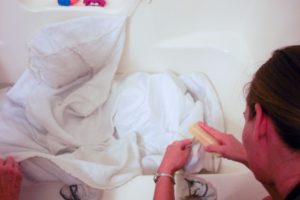
A non-standard product for removing stains from delicate fabrics is baby powder. The powder is poured onto the spot, after which you should wait about 3 hours until the composition begins to act. After the powder is carefully cleaned off the fabric, there should no longer be a stain underneath it.
Potato starch can help remove greasy stains. It, similar to powder, is applied to the contaminated area, after which it is thoroughly rubbed into the fabric.After ten minutes, you can remove any remaining starch powder from the product.
If the wedding took place in the warmer months, you may find grass marks on the dress. Ammonia can remove them. Green areas on the skirt are treated with a swab soaked in ammonia, after which these areas are washed with ordinary soap. Then you can proceed to the main wash of the product.
Some stubborn stains cannot be removed with folk remedies. Then delicate industrial stain removers will come to the housewife’s aid. For example, OxyClean will easily deal with most stains. In addition, it is excellent for fabrics that require special care. Before using the stain remover, you should carefully read the instructions, dilute the solution according to the prescribed dosages, and treat the desired areas. After the stain has completely disappeared, you should begin the main wash process.
Cleaning a dirty hem
Usually there are no special problems with cleaning the hem. To deal with dirt, you should prepare a soap solution. The algorithm for washing the hem of a wedding dress will be as follows:
- dilute the required amount of soap or other liquid product in warm water;
- immerse the hem in the liquid for a couple of hours;
- Using a small brush, carefully brush the entire length of the hem of the dress.
After the main contaminants have been removed, you can wash the hem in the usual way. Rinse your petticoat well. If necessary, you can brush along the edge a couple of times.
The nuances of hand washing
If you decide to wash your wedding attire by hand at home, you should take into account some recommendations from experts. By following a number of simple rules when cleaning, you can achieve a stunning effect and maximum cleanliness of the bride's dress. What should be done?
- Fill a third of the bath with water heated to 25-30°C, no more.

- Add the required amount of soap, liquid gel, soft powder, and dissolve it well in water.
- Soak the dress in soapy water for 30-60 minutes.
- Using a sponge, use gentle pressure movements to go over the stains on the item. When cleaning, do not rub the fabric too hard.
- After removing all visible dirt from the material, leave the outfit in soapy water for another couple of hours.
- Drain the waste water and collect clean water for further rinsing of the dress. Actively use the shower to help remove detergent residue from the fabric fibers.
You should not additionally pour the product into the water if there is already a dress there, this will negatively affect the quality of the wash, since the substance will simply clog into the product without having time to completely dissolve.
There is another method that allows you to clean your dress by hand. Detailed instructions for action will be as follows:
- put the bride's dress on a hanger and hang it above the bathtub;
- take a shower head and wet the item well on all sides;
- make a soap solution in a separate container;
- Dipping a sponge into the liquid, begin to clean the contaminated fabric;
- After the product has been processed, start rinsing. To do this, lift the shower head and rinse the soap mixture from top to bottom.
If the dress has a decorative pattern or other decoration, it is better to cover the composition with fabric or thick gauze, and only then start washing, this will protect the pattern from mechanical damage. Metal elements sewn onto a bodice or skirt are pre-treated with glycerin.This event will allow the decor not to fade from exposure to water.
Drying Features
 After finishing washing, it is very important to dry the dress properly and smooth the product well. It is strictly forbidden to twist the wedding dress to squeeze out excess water from it. After intensive spinning, the material may become deformed and lose its original appearance forever. There are several ways to dry a bulky item.
After finishing washing, it is very important to dry the dress properly and smooth the product well. It is strictly forbidden to twist the wedding dress to squeeze out excess water from it. After intensive spinning, the material may become deformed and lose its original appearance forever. There are several ways to dry a bulky item.
- Using regular hangers. Hang the dress on a hanger and hang it over the bathtub. The folds will straighten out on their own during drying. But you should understand that a wet outfit hanging in this way may undergo some deformation under its own weight.
- Laying the product out on a horizontal surface. This drying option is considered safer. You can install a special grate at the bottom of the bathtub, and put the bride's dress on top. So, after a few hours, the main water will safely drain into the sewer. And only after this the garment is hung on “hangers”, straightened out, and dried in a vertical position.
It is important to straighten the fabric layers well to avoid the formation of folds and creases.
The wedding dress can be dried on the balcony, but you should make sure that it is not exposed to direct sunlight, otherwise the snow-white fabric may simply turn yellow. It is not advisable to dry formal attire near heaters or radiators.
As you can see, there is nothing difficult about cleaning the bride’s dress yourself. It is better not to put the item in the washing machine, but to wash it by hand in cool water with the addition of gentle detergents. Proper drying will prevent deformation of the product and avoid long and painful ironing of unstraightened folds.
Interesting:
Reader comments
- Share your opinion - leave a comment
Categories
Washing machine repair


For buyers

For users

Dishwasher

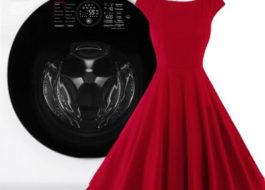
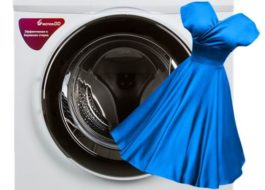

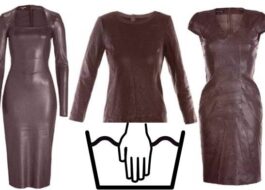
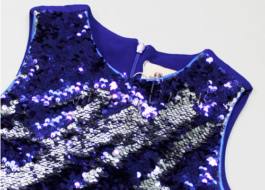
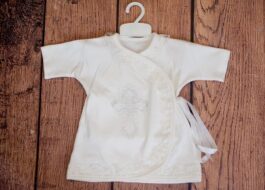










Add a comment